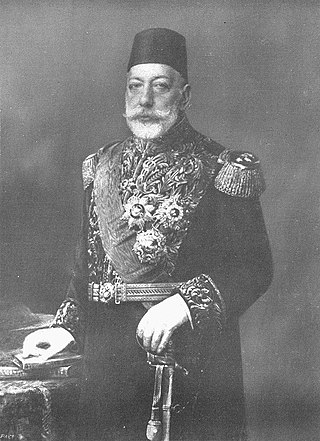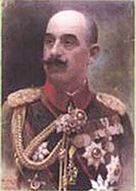
Mehmed VI Vahideddin, also known as Şahbaba among the Osmanoğlu family, was the last sultan of the Ottoman Empire and the penultimate Ottoman caliph, reigning from 4 July 1918 until 1 November 1922, when the Ottoman sultanate was abolished and replaced by the Republic of Turkey on 29 October 1923.

Mehmed V Reşâd was the penultimate sultan of the Ottoman Empire from 1909 to 1918. Mehmed V reigned as a constitutional monarch, interfering little when it came to government affairs, though the constitution was held with little regard by his ministries. The first half of his reign was marked by contentious politicking between factions of the Young Turks, and the second half by war and domination of the Committee of Union and Progress and the Three Pashas.

Abdulmejid II or Abdulmecid II was the last Ottoman caliph, the only caliph of the Republic of Turkey, and head of the Osmanoğlu family from 1926 to 1944. As opposed to previous caliphs, he used the title Halîfe-i Müslimîn, instead of Emîrü'l-Mü'minîn.

The Turkish War of Independence was a series of military campaigns and a revolution waged by the Turkish National Movement, after parts of the Ottoman Empire were occupied and partitioned following its defeat in World War I. The conflict was between the Turkish Nationalists against Allied and separatist forces over the application of Wilsonian principles, especially national self-determination, in post-World War I Anatolia and Eastern Thrace. The revolution concluded the collapse of the Ottoman Empire; the Ottoman monarchy and the Islamic caliphate were abolished, and the Republic of Turkey was declared in Anatolia and Eastern Thrace. This resulted in a transfer of vested sovereignty from the sultan-caliph to the nation, setting the stage for Republican Turkey's period of nationalist revolutionary reform.

The caliphate of the Ottoman Empire was the claim of the heads of the Turkish Ottoman dynasty to be the caliphs of Islam in the late medieval and early modern era. During the period of Ottoman expansion, Ottoman rulers claimed caliphal authority after the conquest of Mamluk Egypt by sultan Selim I in 1517 and the abolition of the Mamluk-controlled Abbasid Caliphate. This left Selim as the Defender of the Holy Cities of Mecca and Medina and strengthened the Ottoman claim to leadership in the Muslim world.

The dissolution of the Ottoman Empire (1908–1922) was a period of history of the Ottoman Empire beginning with the Young Turk Revolution and ultimately ending with the empire's dissolution and the founding of the modern state of Turkey.

Musa Kâzım Karabekir was a Turkish general and politician. He was the commander of the Eastern Army of the Ottoman Empire during the Turkish War of Independence, and fought a successful military campaign against the Armenian Democratic Republic. He was the a founder and leader of the Progressive Republican Party, the Turkish Republic's first opposition party to Atatürk, though he and his party would be purged following the Sheikh Said revolt. He was rehabilitated with İsmet İnönü's ascension to the presidency in 1938 and served as Speaker of the Grand National Assembly of Turkey before his death.

The Turkish National Movement, also known as the Anatolian Movement, the Nationalist Movement, and the Kemalists, included political and military activities of the Turkish revolutionaries that resulted in the creation and shaping of the modern Republic of Turkey, as a consequence of the defeat of the Ottoman Empire in World War I and the subsequent occupation of Constantinople and partitioning of the Ottoman Empire by the Allies under the terms of the Armistice of Mudros. The Turkish revolutionaries rebelled against this partitioning and against the Treaty of Sèvres, signed in 1920 by the Ottoman government. Most revolutionaries were former members of the Committee of Union and Progress.

The Kuvâ-i İnzibâtiyye was an army established on 18 April 1920 by the imperial government of the Ottoman Empire in order to fight against the Turkish National Movement during the Turkish War of Independence in the aftermath of World War I. It was commanded by Süleyman Şefik Pasha.
The 150 personae non gratae of Turkey is a list of high-ranking personages of the Ottoman Empire who were exiled from the Republic of Turkey shortly after the end of the Turkish War of Independence with the Armistice of Mudanya on 11 October 1922. The Sultanate was abolished by the Grand National Assembly of Turkey in Angora (Ankara) on 1 November 1922, and the last Ottoman Sultan, Mehmed VI, was declared persona non grata. Leaving Istanbul aboard the British warship HMS Malaya on 17 November 1922, he was sent into exile and died in Sanremo, Italy, on 16 May 1926.

Ahmed Tevfik Pasha, later Ahmet Tevfik Okday after the Turkish Surname Law of 1934, was an Ottoman statesman of Crimean Tatar origin. He was the last grand vizier of the Ottoman Empire. He held the office three times, the first in 1909 under Sultan Abdul Hamid II, and from 1918 to 1919 and from 1920 to 1922 under Mehmed VI during the Allied occupation of Istanbul. In addition to his premiership, Ahmet Tevfik was also a diplomat, a member of the Ottoman Senate, and long time Minister of Foreign Affairs.

Damat Mehmed Adil Ferid Pasha, known simply as Damat Ferid Pasha, was an Ottoman liberal statesman, who held the office of Grand Vizier, the de facto prime minister of the Ottoman Empire, during two periods under the reign of the last Ottoman Sultan Mehmed VI, the first time between 4 March 1919 and 2 October 1919 and the second time between 5 April 1920 and 21 October 1920. Officially, he was brought to the office a total of five times, since his cabinets were recurrently dismissed under various pressures and he had to present new ones. Because of his involvement in the Treaty of Sèvres, his collaboration with the occupying Allied powers, and his readiness to acknowledge atrocities against the Armenians, he was declared a traitor and subsequently a persona non grata in Turkey. He emigrated to Europe at the end of the Greco-Turkish War.

The occupation of Istanbul or occupation of Constantinople, the capital of the Ottoman Empire, by British, French, Italian, and Greek forces, took place in accordance with the Armistice of Mudros, which ended Ottoman participation in the First World War. The first French troops entered the city on 12 November 1918, followed by British troops the next day. The Italian troops landed in Galata on 7 February 1919.

The Kuva-yi Milliye were irregular Turkish militia forces active in the early period of the Turkish War of Independence. These irregular forces emerged after the occupation of the parts of Turkey by the Allied forces in accordance with the Armistice of Mudros. Later, Kuva-yi Milliye were integrated to the regular army of the Grand National Assembly. Some historians call this period (1918–20) of the Turkish War of Independence the "Kuva-yi Milliye phase".

The Osmanoğlu family are the members of the historical House of Osman, which was the namesake and sole ruling house of the Ottoman Empire from 1299 until the establishment of the Republic of Turkey in 1923.

The Government of the Grand National Assembly, self-identified as the State of Turkey or Turkey, commonly known as the Ankara Government, or archaically the Angora Government, was the provisional and revolutionary Turkish government based in Ankara during the Turkish War of Independence (1919–1923) and during the final years of the Ottoman Empire. It was led by the Turkish National Movement, as opposed to the crumbling Constantinople Government/Istanbul Government, which was led by the Ottoman Sultan.
The Konya rebellion, also known as the Delibaş Rebellion named after the rebel leader Delibaş Mehmet Agha, was an uprising in Konya against the Turkish national movement during the Turkish War of Independence.

The Ottoman Caliphate, the world's last widely recognized caliphate, was abolished on 3 March 1924 by decree of the Grand National Assembly of Turkey. The process was one of Atatürk's reforms following the replacement of the Ottoman Empire with the Republic of Turkey. Abdulmejid II was deposed as the last Ottoman caliph, as was Mustafa Sabri as the last Ottoman Shaykh al-Islām.




















